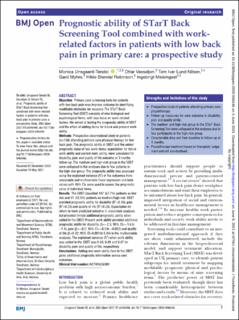| dc.contributor.author | Unsgaard-Tøndel, Monica | |
| dc.contributor.author | Vasseljen, Ottar | |
| dc.contributor.author | Nilsen, Tom Ivar Lund | |
| dc.contributor.author | Myhre, Gard | |
| dc.contributor.author | Robinson, Hilde Stendal | |
| dc.contributor.author | Meisingset, Ingebrigt | |
| dc.date.accessioned | 2021-06-10T07:44:26Z | |
| dc.date.available | 2021-06-10T07:44:26Z | |
| dc.date.created | 2021-06-04T11:44:29Z | |
| dc.date.issued | 2021 | |
| dc.identifier.citation | BMJ Open. 2021, 11 (6), . | en_US |
| dc.identifier.issn | 2044-6055 | |
| dc.identifier.uri | https://hdl.handle.net/11250/2758759 | |
| dc.description.abstract | Objective Primary care screening tools for patients with low back pain may improve outcome by identifying modifiable obstacles for recovery. The STarT Back Screening Tool (SBST) consists of nine biological and psychological items, with less focus on work-related factors. We aimed at testing the prognostic ability of SBST and the effect of adding items for future and present work ability.
Methods Prospective observational study in patients (n=158) attending primary care physical therapy for low back pain. The prognostic ability of SBST and the added prognostic value of two work items; expectation for future work ability and current work ability, were calculated for disability, pain and quality of life outcome at 3 months follow-up. The medium and high-risk group in the SBST were collapsed in the analyses due to few patients in the high-risk group. The prognostic ability was assessed using the explained variance (R2) of the outcomes from univariable and multivariable linear regression and beta values with 95% CIs were used to assess the prognostic value of individual items.
Results The SBST classified 107 (67.7%) patients as low risk and 51 (32.3%) patients as medium/high risk. SBST provided prognostic ability for disability (R2=0.35), pain (R2=0.25) and quality of life (R2=0.28). Expectation for return to work predicted outcome in univariable analyses but provided limited additional prognostic ability when added to the SBST. Present work ability provided additional prognostic ability for disability (β=−2.5; 95% CI=−3.6 to −1.4), pain (β=−0.2; 95% CI=−0.5 to −0.002) and quality of life (β=0.02; 95% CI=0.001 to 0.04) in the multivariable analyses. The explained variance (R2) when work ability was added to the SBST was 0.60, 0.49 and 0.47 for disability, pain and quality of life, respectively.
Conclusions Adding one work ability item to the SBST gives additional prognostic information across core outcomes. | en_US |
| dc.language.iso | eng | en_US |
| dc.publisher | BMJ Publishing Group Ltd. | en_US |
| dc.rights | Navngivelse-Ikkekommersiell 4.0 Internasjonal | * |
| dc.rights.uri | http://creativecommons.org/licenses/by-nc/4.0/deed.no | * |
| dc.title | Prognostic ability of STarT Back Screening Tool combined with work-related factors in patients with low back pain in primary care: a prospective study | en_US |
| dc.type | Peer reviewed | en_US |
| dc.type | Journal article | en_US |
| dc.description.version | publishedVersion | en_US |
| dc.source.volume | 11 | en_US |
| dc.source.journal | BMJ Open | en_US |
| dc.source.issue | 6 | en_US |
| dc.identifier.doi | 10.1136/bmjopen-2020-046446 | |
| dc.identifier.cristin | 1913747 | |
| dc.description.localcode | © Author(s) (or their employer(s)) 2021. This is an open access article distributed in accordance with the Creative Commons Attribution Non Commercial (CC BY-NC 4.0) license, which permits others to distribute, remix, adapt, build upon this work non-commercially, and license their derivative works on different terms, provided the original work is properly cited, appropriate credit is given, any changes made indicated, and the use is non-commercial. See: http://creativecommons.org/licenses/by-nc/4.0/. | en_US |
| cristin.ispublished | true | |
| cristin.fulltext | original | |
| cristin.qualitycode | 1 | |

